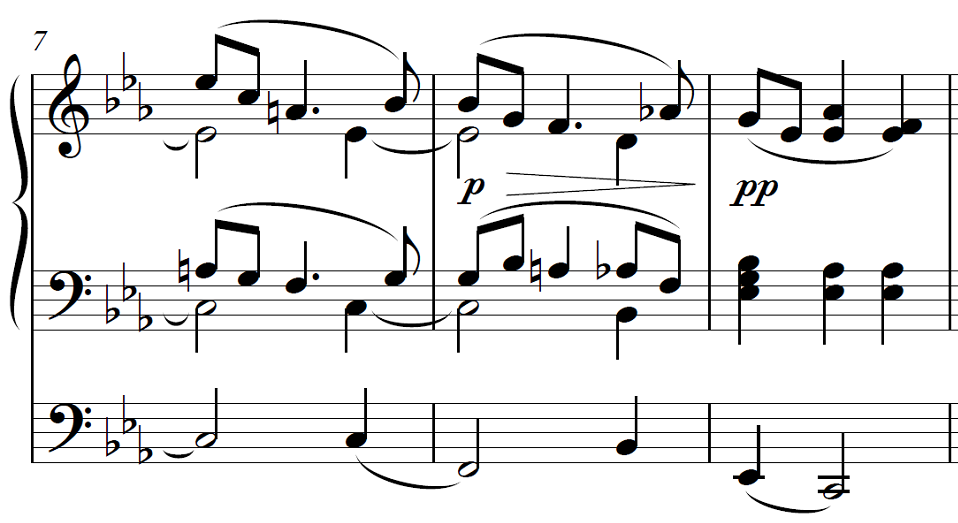
(see also Matrix Video)
Here are measures 7, 8 and 9:

The first chord of measure 8 consists of the notes E♭-B♭-F-C-G. This is a series of pure fifths (ideal pitch ratio 3/2) whose end points (E♭, G) form a major third (ideal pitch ratio 5/4) - I am disregarding octaves here. But the ideal ratios do not match. The ratios of the fifths combine to 3/2 x 3/2 x 3/2 x 3/2 = 81/16. Bringing that down by two octaves yields 81/64, where the ideal major third is 5/4 = 80/64. To 'fix' that, the optimizer is configured to sacrifice one ideal fifth (giving it a pitch ratio 40/27) and keep the major third's ideal pitch ratio 5/4. You can listen to measures 7, 8 an 9 to find out whether the non ideal fifth with pitch ratio 40/27 annoys you:
(measure 7, 8, 9 in tempered just intonation)
Similar chords sound in Sleep by E. Whitacre.
There is more to say about this fragment. The last chord of measure 9 is F-A♭-C-E♭. It sounded bad to me the first few times I listened and occasionally it still does. What is wrong with it? Well, not much if we review the interval analysis below. The pitch ratios between the tones are: F -6/5- A♭ -5/4- C -6/5- E♭. The fifths F-C and A♭-E♭ are both 3/2. A consequence is that the interval F-E♭ has a pitch ratio 9/5. Inverted to a whole tone, that is 10/9. The optimizer routinely assigns this pitch ratio and you can hear many of them in all pieces on this website, both melodically and harmonically. But still, its alternative with pitch ratio 9/8 is less dissonant.
Something else may cause this chord to sound odd: It starts out - on the second beat of measure 9 - as the A♭ major triad, with the third (C) in the bass. Then by the unaccented addition of F on the third beat, it turns into a Fm7 chord. This may be hard to track for our ears in just intonation. So let's hear the same fragment in 12 tone equal temperament:
(measure 7, 8, 9 in 12 tone equal temperament)
You can download zipped .csv files containing the exact intervals used in this piece.
Explanation of column headers.
Before I even considered creating the website, I had listened to each of the earlier pieces on this website a thousand times. Gradually I had forgotten how unusual just intonation sounded in the beginning. But I only started working on Nimrod in October 2018, triggered by a beautiful performance by the Ardemus Saxophone Quartet I heard on Dutch radio (NPO 4, 3 October 2018, 10:53). I downloaded the score of an arrangement for organ by Pierre Gouin, adapted some notes and generated a sound file.
The result disappointed me, because it sounded so out of tune. That improved over time, but the tuning never satisfied me completely. The piece made me think of slow 19th century string quartet music.
In September 2020 I took the obvious next step: rendering the piece with a more strings-like sound. Each note is then played by a chorus of eight (imitations of) narrow flue pipes at 8' pitch. Immediately my uneasiness with the tuning vanished:
(tempered just intonation)
And just to compare: the same in twelve tone equal temperament:
(12 tone equal temperament)
By the way, I find it hard but not impossible to hear the difference between these two latter renderings.